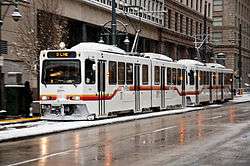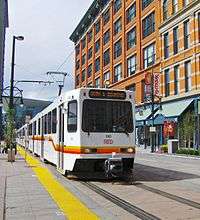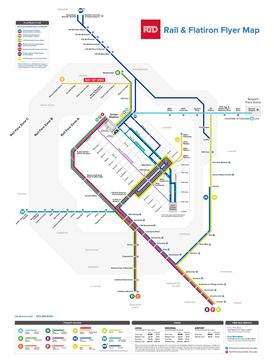RTD Bus & Rail
 | |||
 | |||
|
RTD's three modes of public transit | |||
| Overview | |||
|---|---|---|---|
| Owner | Regional Transportation District | ||
| Locale | Denver Metropolitan Area | ||
| Transit type |
Bus Commuter rail Light rail | ||
| Number of lines |
127 (Bus) 2 (Commuter rail) 8 (Light rail) | ||
| Number of stations | 53 (Rail) | ||
| Daily ridership |
209,100 (Bus)[1] 86,900 (Rail)[1] | ||
| Headquarters |
1600 Blake Street Denver, CO 80202 | ||
| Website | RTD Denver | ||
| Operation | |||
| Began operation |
1969 (Bus) 1994 (Light rail) 2016 (Commuter rail) | ||
| Reporting marks | RTDZ | ||
| Number of vehicles |
969 (Bus) 172 (Rail) | ||
| Technical | |||
| System length | 87.5 mi (140.8 km) (light & commuter rail) (58.5 miles of light rail) (29 miles of commuter rail) | ||
| Track gauge | 4 ft 8 1⁄2 in (1,435 mm) | ||
| Electrification |
Overhead lines, 25k V AC 60 Hz (commuter rail)[2] Overhead lines, 750 V DC (light rail) | ||
| |||

RTD Bus and Rail (branded as TheRide) is a transit system in the Denver, Colorado, metropolitan area. Operated by the Regional Transportation District (RTD), it currently runs 124 local, 16 express, 16 regional, 16 limited, and 8 skyRide bus routes plus some special services. It also includes 8 light rail lines and an additional 2 commuter rail lines with 71 stations and 87.5 miles (140.8 km) of track.[3]
History
Bus
Bus service in Denver dates back to 1924, when Denver Tramway began the first bus between Englewood and Fort Logan. Buses had completely replaced the previously expansive streetcar system in metro Denver by 1950. However, cars were becoming a larger part of life, and ridership was declining. From 1969 to 1971, Denver Tramway required the sponsorship of the City and County of Denver to continue service. In 1971 with aging equipment, low revenues and lackluster ridership, the Denver Tramway Company transferred all of its assets to city-owned Denver Metro Transit.
In 1969, the Regional Transportation District (RTD) was created in the 47th session of the Colorado General Assembly to provide public transportation to five additional counties in the metropolitan area. It acquired privately owned companies, improved service frequency, and expanded to routes that commercial carriers previously operated such as airport buses.[4]
In July 1974, Denver Metro Transit became part of RTD, and under the new banner, ridership began to increase.
Light rail
RTD's first light rail line, a 5.3-mile (8.5 km) section of what is now the D Line, opened on Friday, October 7, 1994. It operated with free service for that half day and the first weekend, with revenue service starting on October 10.[5] It was estimated that more than 200,000 passengers rode the new system during its two-and-a-half-day opening weekend, when the fleet comprised only 11 Siemens SD-100 rail cars.[5]
Since that time, several additional light rail lines have been opened. An 8.7-mile (14.0 km) southwest extension to Mineral Avenue in Littleton opened in July 2000, and the 1.8-mile Platte Valley extension to Denver Union Station opened in April 2002. An additional 19-mile (31 km) Southeast Corridor extension along I-25 to Lone Tree and a branch along I-225 to Parker Road were completed in November 2006 as part of Denver's T-REX project.
As of April 2013, the system had 170 light rail vehicles, serving 47 miles (76 km) of track.[3]
Commuter rail
With the passage of FasTracks, RTD began planning for a series of commuter rail lines. The first 23.5 miles (37.82 km) of which, the A Line servicing Denver International Airport, opened on April 22, 2016.
Current services
Primary services
The primary RTD services are scheduled bus and rail routes.[6] Most bus routes are divided into Local and Regional service levels. Light rail and commuter rail services are divided in four zones: A, B, C and airport. Local service is travel within two consecutive lettered zones, and regional service is within all three lettered zones. The airport zone applies for bus or rail travel into and out of Denver International Airport.
The current commuter rail lines are:
The current light rail lines are:
- C Line: Littleton/Mineral to Union Station
- D Line: Littleton/Mineral to 18th/California & 18th/Stout
- E Line: Lincoln to Union Station
- F Line: Lincoln to 18th/California & 18th/Stout
- H Line: Florida to 18th/California & 18th/Stout
- L Line: 30th/Downing to 16th/California & 16th/Stout
- R Line: Lincoln to Peoria
- W Line: Denver Union Station to Jeffco Government Center
With the opening of the Southeast Corridor, many regional bus routes that provided service from the North Metro to Denver Tech Center were replaced by service to Union Station and light rail from Union Station to the Belleview light rail station. Several regional bus routes to and from the South Metro were also eliminated by the openings of the Southeast & Southwest Corridors, replaced by feeder routes to light rail.
Former services
Special services
Special bus services are offered for various purposes.[8] Some of the more popular special services are:
- "call-n-Ride", which provides curb-to-curb service in specific areas. This is similar to taxis.[9]
- "access-a-Ride", which provides transportation for disabled people.[10]
- "FREE MallRide", the 16th Street Mall shuttle; as its name implies, rides on this service are free. The shuttles are BYD ebuses.[11]
- "skyRide", which provides direct service to Denver International Airport from various locations around the metro area.[12]
- Sporting events service:
- "BroncosRide", which provides direct service to Sports Authority Field at Mile High from various locations around the metro area.[13]
- "RockiesRide", a similar service which provides direct service to Coors Field.[14]
- "RunRide", a similar service which provides direct service to Boulder during the Bolder Boulder 10K road race.
Fares
| Local | Regional | Airport | |
|---|---|---|---|
| Cash | $2.60 | $4.50 | $9 |
| Discount | $1.30 | $2.25 | $4.50 |
| Ticketbook (10 rides) | $23.50 | $40.50 | N/A |
| Discount Ticketbook | $11.75 | $20.25 | N/A |
| Monthly Pass | $99 | $171 | N/A |
| Discount Monthly Pass | $49 | $85 | N/A |
These fares apply only to the primary services. Special services typically cost more, up to thirteen dollars each way for some skyRide routes. Free transfers are available between services going in the same direction, of the same type or cheaper. Passengers may pay for an upgrade to transfer from a lower fare service to a higher fare service, regardless of whether one is special service and the other is not. Discount fares are available with proof of eligibility to seniors over 65, students ages six to nineteen (and still in high school), people with disabilities and people who receive Medicare.[15] No more than three kids below age six ride for free with a fare-paying rider.
Stations
Bus stations
Major bus stations provide termini for Express and Regional routes. Many Local and Limited routes stop near these stations, making transfers between routes relatively easy. Of the three major bus stations in the RTD system, only one—Union Station—is also served directly by light rail trains. None of the three major bus stations is a Park 'n' Ride facility.
| Station Name | Address | Phone Number |
|---|---|---|
| Civic Center Station | 1550 Broadway, Denver, CO 80202 | Lost & Found 303-299-2288 |
| Union Station (rail and bus) | 1701 Wynkoop Street, Denver, CO 80202 | None |
| Boulder Transit Center | 1400 Walnut Street, Boulder, CO 80302 | Lost & Found 303-442-7332 |
Civic Center Station is connected to Union Station via the Free MallRide and Free MetroRide shuttle services.
Market Street Station (16th and Market Street), a major bus station in the RTD system, was closed permanently on May 11, 2014, after thirty years of continuous use. All bus routes that formerly served Market Street Station were re-routed to the renovated Union Station, four blocks to the northwest.
Light rail stations
Light rail stations serve the light rail system and many of these stations have gates for bus service also. As of 2018, there are 55 stations on the eight lines in the RTD Light Rail system. RTD has adopted specific design standards that are incorporated into its station design, with a specific emphasis on the platform, its transition plaza and the multi-modal access provided at the facility.[16] Platforms are designed to accommodate four-car trains and may be in either a side, island or side center style.[16] The transition plaza is the area where tickets are purchased and passenger services can be found.[16] Additionally, all stations include works of public art as part of RTD's art-n-Transit program. These works include independent works or as pieces incorporated into the canopies, columns, pavers, windscreens, fencing and landscaping present at all stations.[17]
Park-n-Rides
A number of light rail stations in the RTD system, as well as a number of bus stops located away from the three major bus stations, are attached to dedicated RTD parking facilities. These are the Park-n-Ride locations. As of 2014, there are more than 70 RTD Park-n-Ride facilities with an aggregate total of more than 30,000 parking spaces.[18]
Future services
RTD has two further commuter rail lines opening through 2018. Also, extensions to the Northwest, Southwest, Southeast and Central corridor lines are planned via the FasTracks project.
Art on the light rail system
In 1977, Colorado passed the Art in Public Places bill which required that 1 percent of all state-funded construction budgets be used to purchase art.[19] About $1 million from the T-REX contingency budget was dedicated to art projects at each of the 13 new southeast corridor light rail stations as part of RTD's art-n-Transit program.[17]
- Ira Sherman, "Stange Machine," Louisiana/Pearl Station
- Ries Niemi, "Big Boots," Colorado Station
- John Goe, "Reflective Discourse," University Station
- Gregory Gove, "Connected," Yale Station
- Chris Janney, "Harmonic Pass: Denver," Southmoor Station
- Richard Elliott, "Thunder Over the Rockies," Belleview Station
- Christopher Weed, "Windswept," Dayton Station
- Dwight Atkinson, "Yet Another Way To Know That Nature Will Eventually Win," Nine Mile Station
- Wopo Holup, "Orchard Memory," Orchard Station
- Michael Clapper, "Nucleus," Arapahoe at Village Center Station
- John McEnroe, "Fools Gold," Dry Creek Station
- Emmett Culligan, "Plow," County Line Station
- Ray King, "Sun Stream," Lincoln Station
Design team artists who worked on windscreen benches, railings, bike racks and canopy columns at all stations were Susan Cooper and Rafe Ropek.
References
- 1 2 "APTA Transit Ridership Report" (PDF). APTA. Retrieved 2014-03-11.
- ↑ "Commuter train testing begins on G Line". RTD FasTracks. Regional Transportation District of Denver. Retrieved 25 July 2016.
- 1 2 "RTD - Facts and Figures". RTD. Retrieved 2012-02-05.
- ↑ Gutfreund, Owen (2004). Twentieth century sprawl : highways and the reshaping of the American Landscape. New York: Oxford University Press. ISBN 9780195141412.
- 1 2 Pacific RailNews, January 1995, p. 68. Pentrex. ISSN 8750-8486.
- ↑ Routes Archived 2007-01-08 at the Wayback Machine.
- ↑ "RTD - I-225 Rail Line". Regional Transportation District. Retrieved January 29, 2015.
- ↑ Special Rides Archived 2007-09-27 at the Wayback Machine.
- ↑ call-n-Ride Archived 2006-12-30 at the Wayback Machine.
- ↑ access-a-Ride
- ↑ "Denver RTD to purchase 36 new BYD electric buses for mall service". Metro Magazine. 2015-08-25. Retrieved 2018-01-30.
- ↑ skyRide
- ↑ BroncosRide Archived 2006-12-30 at the Wayback Machine.
- ↑ "Convenient, Affordable, Fast and Fun. RockiesRide Is A Grand Slam!". Archived from the original on 2006-02-07.
- ↑ "RTD — Fares". Archived from the original on 2014-06-25. Retrieved 2013-01-05.
- 1 2 3 "Station design criteria" (PDF). RTD Design Guidelines & Criteria, Light Rail Design Criteria. Regional Transportation District. November 2005. Archived from the original (PDF) on September 14, 2012. Retrieved September 26, 2010.
- 1 2 "art-n-Transit: A rider's guide to public art on RTD's transit system". Regional Transportation District. Retrieved September 26, 2010.
- ↑ "List of Park-n-Ride locations". Regional Transportation District. Retrieved June 23, 2014.
- ↑ Kyle MacMillan. "Lawmaker working to patch hole in "1 percent for art" statute". Denver Post.
External links
- Rachel Mendelson, Marta Ivanek (2014-10-02). "How Denver's mile-high ambition is a road map for Toronto transit". Toronto Star. Archived from the original on 2014-10-08.
Not a year earlier, Denver voters had rejected a tax to fund a major light-rail expansion, but business leaders were determined to try again. They believed the so-called Mile-High City would need more than buses to lift it from middling to world-class, and efforts to rebuild the campaign were already underway.
- "ICYMI People are talking about Denver transit". Toronto Star. 2014-10-06. Archived from the original on October 8, 2014.
Metro Denver Small Business Development Center shared the story with its readers. RT @MetroDenverEDC Metro #Denver's #transit gets global attention this week, serving as a blueprint for #cities...


